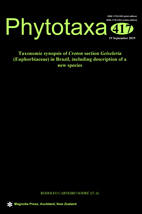Abstract
Croton is the second largest genus of Euphorbiaceae with about 1200 tropical species. Of these, over 715 species are native to the Americas and have been assigned to 31 sections. Croton sect. Geiseleria includes about 80 species distributed from the United States to Argentina; they are especially diverse in Brazil, where about two thirds of its species occur. Many specimens from this section have been erroneously identified and require proper typification. We present a taxonomic synopsis of C. sect. Geiseleria for Brazil, based on the analysis of over 2000 specimens from 60 herbaria and our own collections from dozens of excursions to multiple regions of the country. Fifty species in the section are recognized here for Brazil, 37 of them endemic to the country, among which C. seccoi is described as new to science. Three species (C. carinatus, C. catariae, and C. mollis) are newly transferred to the section based on morphological analysis. Twenty-seven new synonyms, 70 lectotypes and one neotype are proposed. All of the species are included in an identification key, and then comments on their geographic distributions, habitats, phenologies, conservation status, and diagnostic characteristics are provided. Finally, distribution maps, original illustrations, and photographs are provided for most of the species.

